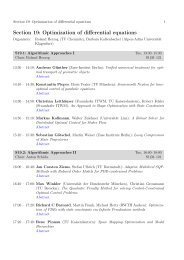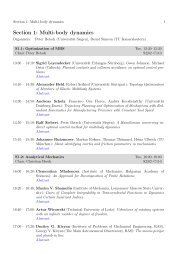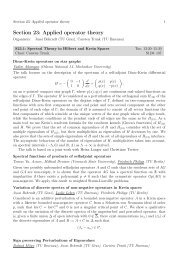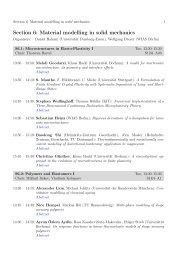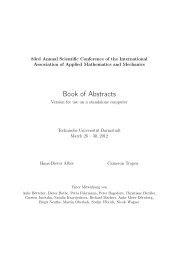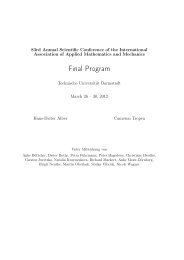Section 6: Material modelling in solid mechanics - GAMM 2012
Section 6: Material modelling in solid mechanics - GAMM 2012
Section 6: Material modelling in solid mechanics - GAMM 2012
Create successful ePaper yourself
Turn your PDF publications into a flip-book with our unique Google optimized e-Paper software.
6 <strong>Section</strong> 6: <strong>Material</strong> <strong>modell<strong>in</strong>g</strong> <strong>in</strong> <strong>solid</strong> <strong>mechanics</strong><br />
k<strong>in</strong>ematics at the cont<strong>in</strong>uum scale. As a result the total energy becomes non-convex, thus giv<strong>in</strong>g<br />
rise to the development of microstructure. To guarantee the existence of m<strong>in</strong>imizers an exact<br />
quasi-convex envelope of the correspond<strong>in</strong>g energy functional is derived. As a result microstructure<br />
occurs <strong>in</strong> both the displacement and micro-rotation field. The correspond<strong>in</strong>g relaxed energy<br />
is then used for f<strong>in</strong>d<strong>in</strong>g the m<strong>in</strong>imizers of the two field m<strong>in</strong>imization problem correspond<strong>in</strong>g to a<br />
Cosserat cont<strong>in</strong>uum. F<strong>in</strong>ite element formulation and numerical simulations are presented. Analytical<br />
and numerical results are discussed.<br />
About the Microstructural Effects of Polycrystall<strong>in</strong>e <strong>Material</strong>s and their Macroscopic<br />
Representation at F<strong>in</strong>ite Deformation<br />
Eva Lehmann, Stefan Loehnert, Peter Wriggers (Universität Hannover)<br />
In the sheet bulk metal form<strong>in</strong>g field, the strict geometrical requirements of the workpieces result<br />
<strong>in</strong> a need of a precise prediction of the material behaviour. The simulation of such form<strong>in</strong>g processes<br />
requires a valid material model, perform<strong>in</strong>g well for a huge variety of different geometrical<br />
characteristics and f<strong>in</strong>ite deformation.<br />
Because of the crystall<strong>in</strong>e nature of metals, anisotropies have to be taken <strong>in</strong>to account. Macroscopically<br />
observable plastic deformation is traced back to dislocations with<strong>in</strong> considered slip<br />
systems <strong>in</strong> the crystals caus<strong>in</strong>g plastic anisotropy on the microscopic and the macroscopic level.<br />
A f<strong>in</strong>ite crystal plasticity model is used to model polycrystall<strong>in</strong>e materials <strong>in</strong> representative<br />
volume elements (RVEs) of the microstructure. A multiplicative decomposition of the deformation<br />
gradient <strong>in</strong>to elastic and plastic parts is performed, as well as a volumetric-deviatoric split of the<br />
elastic contribution. In order to circumvent s<strong>in</strong>gularities stemm<strong>in</strong>g from the l<strong>in</strong>ear dependency<br />
of the slip system vectors, a viscoplastic power-law is <strong>in</strong>troduced provid<strong>in</strong>g the evolution of the<br />
plastic slips and slip resistances.<br />
The model is validated with experimental microstructural data under deformation. The validation<br />
on the macroscopic scale is performed through the reproduction of the experimentally<br />
calculated <strong>in</strong>itial yield surface. Additionally, homogenised stress-stra<strong>in</strong> curves from the microstructure<br />
build the outcome for a suitable effective material model. Through optimisation techniques,<br />
effective material parameters can be determ<strong>in</strong>ed and compared to results from real form<strong>in</strong>g processes.<br />
A rheological model for arbitrary symmetric distortion of the yield surface<br />
A.V. Shutov, J. Ihlemann (TU Chemnitz)<br />
A new rheological model is presented, which provides <strong>in</strong>sight <strong>in</strong>to phenomenological <strong>modell<strong>in</strong>g</strong> of<br />
comb<strong>in</strong>ed nonl<strong>in</strong>ear k<strong>in</strong>ematic and distortional harden<strong>in</strong>g. The model is constructed by coupl<strong>in</strong>g<br />
idealized two-dimensional rheological elements like Hooke-body, Newton-body, and modified St.<br />
Venant element [1,2]. The symmetric distortion of the yield surface and its orientation depend<strong>in</strong>g<br />
on the recent load<strong>in</strong>g path are captured by the rheological model <strong>in</strong> a vivid way. We emphasize the<br />
flexibility of the proposed approach s<strong>in</strong>ce it can be used to capture any smooth convex saturated<br />
form of the yield surface observed experimentally, if the yield surface is symmetric with respect to<br />
the recent load<strong>in</strong>g direction. In particular, an arbitrary sharpen<strong>in</strong>g of the saturated yield locus <strong>in</strong><br />
the load<strong>in</strong>g direction comb<strong>in</strong>ed with a flatten<strong>in</strong>g on the opposite side can be taken <strong>in</strong>to account<br />
[2]. Moreover, the yield locus evolves smoothly and its convexity is ensured at each harden<strong>in</strong>g<br />
stage.<br />
The rheological model serves as a guidel<strong>in</strong>e for construction of new constitutive relations. The<br />
k<strong>in</strong>ematic assumptions, the ansatz for the free energy and for the yield function are motivated by<br />
the rheological model. Additionally to k<strong>in</strong>ematic and distortional harden<strong>in</strong>g, a nonl<strong>in</strong>ear isotropic<br />
harden<strong>in</strong>g is <strong>in</strong>troduced as well. Normality flow rule is considered, and a rigorous proof of ther-



